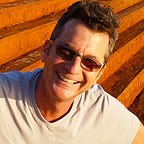The Israeli art version of Lyrical Abstract
A major turning point in Israeli art came about with the formation of the artistic group New Horizons. Interestingly, it happened in 1948, the same year Israel declared its independence. The circumstance of the group’s formation is full of intrigue and drama, but I’ll keep that story for later because it’s more important to first acknowledge and appreciate the essence of the group’s creative force and influence on Israeli art that came ever after.
New Horizons offered a direction, a promise, a door to a new world. Although there was no stylistic or ideological common denominator for the works of all its members, there was a shared desire to avoid an explicit representation of reality. The group was formed when the narrative of Israeli art was moving from expressions of the collective Zionist ethos to a person’s personal experience. It reflected the struggle between the “social art” camp and its rivals who advocated “art for art” and the “local” versus the “universalists.”
New Horizons principle style is known as ‘Lyrical Abstract.’ It was an Israeli localized version of the abstract painting style that has long been developed in Europe and the United States. In its Israeli context, ‘Lyrical Abstraction’ is characterized by exploitation of the figurative subject as a starting point and a source of influence. Painters freely dismantled that subject for abstraction purposes and yet it always seems to look as if the figurative subject is at the bottom edge of the painting.
A few art historians think that the style mimics the ‘Israeli state of mind’ of the newly created state, which can be characterized by notions of: erase, blur, forget, silence the past and move on towards a creation of new Israeli, a new Jew — the Sabra (the Hebrew name of the Prickly Pear Cactus fruit).
The most prominent artist identified with the ‘Lyrical Abstract’ style is Yossef Zaritsky, who in addition to his artistic talent, possessed a charismatic and strong personality that made him the leader of the group. He was influenced by the French painter Henry Matisse. Zaritsky’s paintings are divided into many sections, each is equal in terms of color density and brush strokes, which creates a surface with no formal tensions, with no literary plot. His color strokes start with a very thin layers of color and end with deep, dense and opaque color. The paintings are dynamics and musical. Light has a supreme role, which he achieves by creating colorful contrasts of dark and light regions. I get a sense of poetic tenderness from his paintings, especially because of the white untouched parts of the canvas.
The culmination of Zaritsky’s abstraction process is in a series of 24 paintings named: ‘Yehiam — Life on the Kibbutz,’ created between 1949 and 1951. Following a painting seminar, he conducted at Kibbutz Yehiam, Zaritsky returned and drew the landscapes of the kibbutz. Yehiam had just been established (1949) in the Western Galilee and Zaritsky was fascinated by the spirit of the kibbutz youth and the colonization of nature by man. The paintings color gamut is usually bright and monochromatic, often using shades of green and blue. The natural landscape is partially conquered by houses and some are not, indicated by the green hue. In the series Yehiam, Zaritsky does not describe reality but uses it to create, what some consider, his best achievement.
Now back to the story of the group formation: I think it was a case of a charismatic and opinionated personalities, aggressively pushing for control and influence. Of course, to know where the truth lies is confusing because it’s often more about the writer’s opinion than the full story. Nevertheless, it’s a good story so here it is as Yossef Zaritsky told it. After World War II, Italy decided to revive the ‘Venice Biennale’. Because Zaritsky was affiliated with the Painters’ Association, he was contacted and informed that the Italians were ready to give the Israelis representation in the exhibition and that there was room for eight painters and one sculptor. The problem was that the selections had to be decided immediately because the ship that was supposed to take the works of art was already docked at the port and had to leave for Italy. Therefore, Zaritsky decided to take the initiative and did not wait for the Association’s meeting but gathered a few painters with a common drawing language who quickly issued a prospect and joined the exhibition in Italy. All this happened a week before the State of Israel declared its independence.
There was no process of external judgment or dimension of public transparency, but a powerful and un-democratic act whose main objective, some say, was self-promotion. When it became known to the rest of the ‘Painters’ Association’, they held an assembly and decided to expel Zaritsky. The painters who participated in the exhibition decided not to leave Zaritsky alone and left as well. This group established New Horizons, and included Yehezkel Streichman, Avigdor Stematsky, Marcel Yanko and Moshe Castel.
New Horizons left a deep mark on Israeli artists’ approach to international art, innovations and progress. Today, the Israeli artist seems to have taken for granted the need to create a connection with the artistic developments around the world. This concept did not take place in the country before New Horizons.
One may ask: why did you include photos of your mother visiting an art museum in a blog about New Horizons and Yossef Zaritsky? The answer is multifold, but the bottom line is this: if I have any ‘eye’ for the arts, it all started with my mother; I have much to say about it but that’s for another blog.
For additional photographs please check my site
